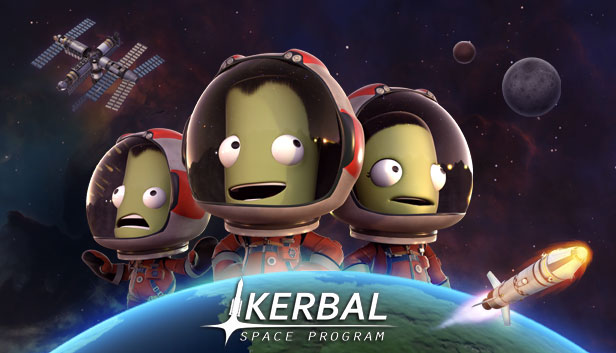Kerbal Space Program is a sandbox game released by Private Division, here are all planets and moons guide in the game.
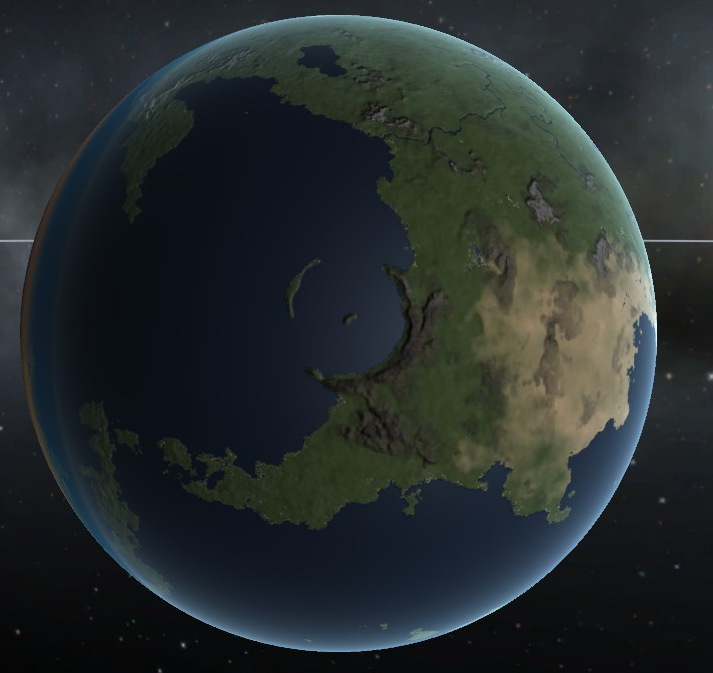
Kerbin
Kerbin is the home planet of the Kerbals, the location of the Space Center, and the main focus of Kerbal Space Program. It is also the Earth analog for the game and has two moons named Mun and Minmus.
Kerbin is the third planet in orbit around the star Kerbol. It is the third largest celestial body that orbits Kerbol, following Jool and Eve. Jool’s moon Tylo has the same radius of Kerbin, though it may be classified as larger, as the highest point on Tylo is about 5 km higher than the highest point on Kerbin. However, Tylo has only 80% of Kerbin’s mass.
Reaching a stable orbit around Kerbin is one of the first milestones a player might achieve in the game. With the introduction of version 1.0.3, attaining low Kerbin orbit requires a Δv of approximately 3400 m/s (vacuum), though the exact amount depends on the efficiency of the ascent profile and the aerodynamics of the launch vehicle and payload. The only planet that requires a higher Δv to attain orbit is Eve. Many interplanetary missions expend over half of their Δv in reaching Kerbin orbit. The velocity required to escape a body from a given altitude is always exactly the square root of two times the velocity of a circular orbit around the body at that height.
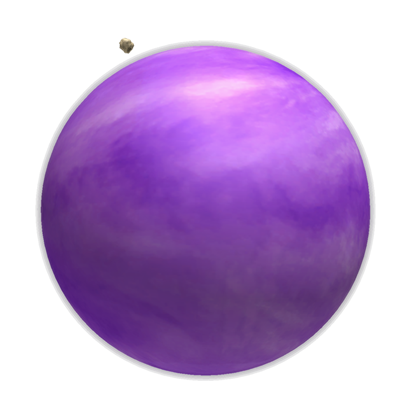
Eve
Eve is the second planet from Kerbol, the closest planet to Kerbin, and KSP’s analogue for the planet Venus. It has one small moon: a captured asteroid called Gilly. It is especially notable for its extremely thick, dense atmosphere, which makes aerobraking and returning two of the most dangerous activities in the game. Additionally, Eve has the greatest surface gravity of all the planets, and the second highest escape velocity, second only to Jool.

Duna
Duna is the fourth planet from Kerbol and the fourth-largest planet. It is the Mars analog for Kerbal Space Program. It has one tidally-locked and large natural satellite, the moon Ike. Duna is a terrestrial planet with a red-brown surface and polar ice caps similar to that of Kerbin.
Duna’s orbit has nearly the same inclination as Kerbin around Kerbol, making the planet one of the easiest to encounter. If the planets align properly, using a ballistic insertion burn from 100km, with proper aerobraking, a round trip from Kerbin to orbit around Duna and back requires ~1700 m/s of LKO delta-v, a relatively low amount compared to other interplanetary destinations. The trip may require a considerably higher delta-v budget for different orientations of Kerbin and Duna.

Jool
Jool is a gas giant and the sixth planet of the Kerbol star system. It is the Jupiter analog for Kerbal Space Program. Aside from Kerbol, Jool has the largest diameter and greatest mass of all celestial bodies. Its extremely high gravity makes orbital maneuvers unpleasantly expensive. While its distance from Kerbin makes it difficult to reach, it is one of the most appealing targets for missions due to its large and complex system of five moons: Laythe, Vall, Tylo, Bop, and Pol. It was possible to land and plant flags on Jool[1] before v0.23. In versions following 0.23, the craft won’t stop at an altitude of -100 m, instead it will continue descending until it gets to -250 m. At this point, anything that hits this altitude at any speed will be completely destroyed.
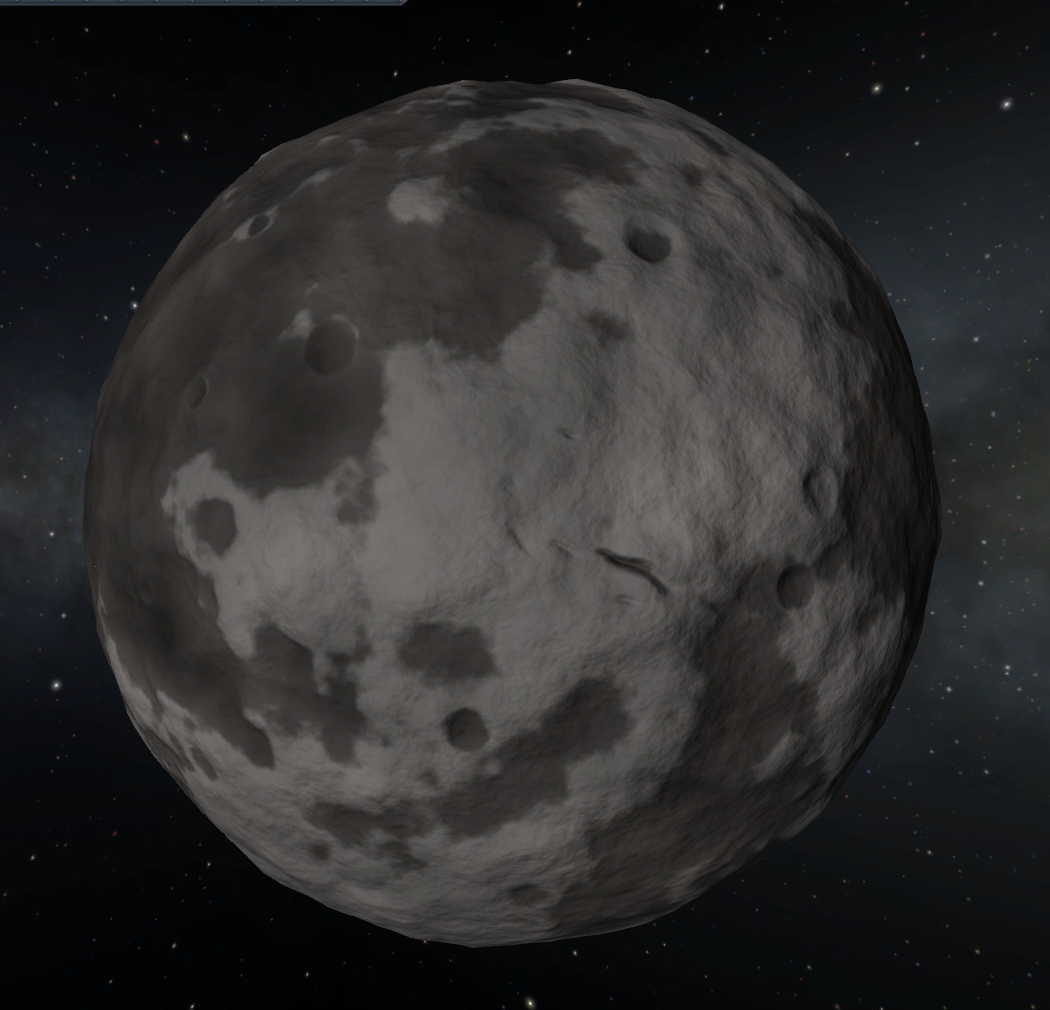
Dres
Dres is the fifth planet in the Kerbol star system. It is located between Duna and Jool in a somewhat eccentric and inclined orbit. It is considered to be the Ceres analog for the game. It is similar to Moho and Eeloo in that it has no atmosphere and no natural satellites (aside from a ring system of asteroids). Dres has the least gravity of any planet in the Kerbol system. Dres is considered a dwarf planet by the game because it has not “cleared its neighborhood”; in other terms, it has asteroids in close proximity.

Eeloo
Eeloo is a dwarf planet that was released in version 0.18.2 as a Christmas gift to the KSP community. It is the seventh and farthest planet from Kerbol most of the time, though its orbit intersects Jool’s, passing in front of it for a minority of its revolution period. The two planets are locked in a 3:2 resonance, which, coupled with their different inclinations, ensures they cannot collide.
Eeloo has just 3.5% more gravity than the Mun and is very similar in size. Like the Mun, it has no atmosphere. The physical characteristics of Eeloo are most likely an analogue of the ice moon Europa, and its orbit is similar to that of Pluto, though both bodies are known to have a tenuous atmosphere.
Eeloo’s relatively large distance from Kerbol reduces solar power to approximately 4% at Eeloo periapsis and 1.4% at Eeloo apoapsis of the values seen at Kerbin. Bringing additional panels, or an alternate powersource (e.g.: RTGs) is recommended.

Moho
Moho is the third-smallest planet and the one closest to Kerbol, with an orbital period of 102 days, the shortest in the Kerbol system, and an orbital velocity ranging from 12-18km/s, is also the fastest celestial body in Kerbal Space Program. It is the Mercury analogue. Moho lacks an atmosphere and natural satellites. The planet gets its name from the Mohorovičić discontinuity, the boundary between the Earth’s crust and mantle.
Moho’s inclined, low, and eccentric orbit and lack of atmosphere or moons (for aerobraking and gravity assists, respectively) make encountering the planet relatively difficult. Without an atmosphere to retain or block heat, Moho’s daytime surface temperatures can exceed 300 °C, making radiators an absolute necessity if any part (such as drills or engines) must be cool to operate both safely and effectively. Moho rotates very slowly, its solar day being over 100 times longer than Kerbin’s, which means that reconnaissance satellites will likely wait a long time between targets, but it also means that there may be several opportunities to perform individual measurements across multiple orbits. Although Moho’s close proximity to the sun increases solar panel output to 10.4x that of Kerbin’s at periapsis, excessive heat can cause cooling issues for mining operations and the extremely long nights will necessitate bringing an alternative power source (RTGs or fuel cells) for extended surface operations.

Mun
Mun, also known as the Mun and sometimes written as Mün, is a relatively large moon orbiting Kerbin. It can be thought of as an analogue to Earth’s own moon, which frequently is simply called “the Moon” (Latin: Luna).
It is gray in appearance with craters of various sizes and mountains exceeding 5029 m in height. The gravitational pull on the surface is 1.63 m/s², approximately 5/6 and 8.18 m/s² lower than that of Kerbin and about the surface gravity of Earth’s Moon (1.624 m/s²). It is possible to land on the Mun or use it for gravity assist (gravitational slingshots) to outer bodies such as Minmus or into Kerbol orbit, though such maneuvers do not save very much fuel and are more imprecise. It is, however, useful for plane changes with proper timing.
New players should note that Mun (like the majority of celestial bodies in the game) has no atmosphere. That means parachutes do not work when descending to the surface.
There are anomalous geological formations that can be found on the surface of the Mun.
Synchronous orbit around the Mun is not possible, since it would have to occur at an altitude of 2 970.58 km, beyond the Mun’s sphere of influence. However, putting your spacecraft just outside Mun’s SOI and having the same semi-major axis would make it appear stationary. A normal 25 km orbit can be achieved using around 800 m/s delta V. A semi-synchronous orbit with half the rotation period of the Mun is possible at approximately 1797.41 kilometers.
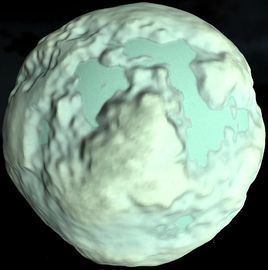
Minmus
Minmus is the smallest moon of Kerbin. From the surface of Kerbin or the Mun, it is a cyan speck one or two pixels wide which appears to slightly oscillate vertically. This is a result of viewing its rotation from afar. Up close, it is off white in appearance with what seem to be icy buttes, large hills, and frozen lakes. The highest areas are over 5.7 km in altitude. It requires somewhat more delta-v to reach Minmus orbit than Mun orbit; however, given its very small gravity, it requires much less to land on the surface and return. This makes Minmus a primary source of Science in the early game after achieving an orbit of Kerbin.
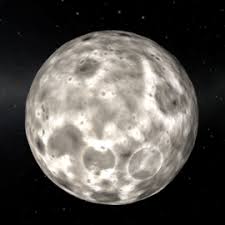 Tylo
Tylo
Tylo is the largest moon of Jool and the Kerbol System, and the largest celestial body without an atmosphere. It is the analog for Ganymede. It is the third moon from Jool, is the same diameter as Kerbin, and is tidally locked. Tylo orbits Jool in roughly nine days. Synchronous orbits around Tylo are impossible, as they would lie far outside of its SOI at a radius of 14,758,067 meters.
Tylo is a relatively difficult target to visit. Its gravity is similar to Kerbin’s, but without an atmosphere, there is no way to aerobrake, and a large amount of fuel must be used to land and take off. However, due to its large gravity well, Tylo is ideal for a gravity assist to enter or leave the Jool system with minimal fuel consumption.
According to former developer NovaSilisko, Tylo was planned to be made into a high-contrasting body like Saturn’s moon Iapetus.
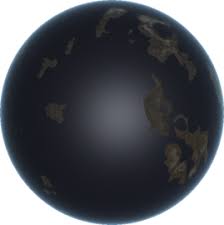 Laythe
Laythe
Laythe is the innermost of the five natural satellites of Jool. Although mostly covered in seas, Laythe has numerous rocky, sandy islands. Laythe is tidally locked to Jool. Synchronous orbits around Laythe are not possible, as they would lie outside of its SOI, at a radius of 5,186,399 meters. A circular archipelago prominent in surface maps of the moon suggests that Laythe suffered a massive impact in its distant past.
Achieving a stable orbit around Laythe from sea level requires a delta-V of ≈2900 m/s.
Laythe has no real-world analogue. In the real-world Jupiter system, the moons Ganymede, Europa and Io form a group with an orbital resonance just like KSP’s Tylo, Vall and Laythe. But while Tylo and Vall have a certain resemblance to their real-life counterparts, Laythe is very unlike Io, which is dry, volcanic, and only has a tenuous atmosphere. Instead, the presence of a liquid ocean, plus a dense atmosphere, makes Laythe more similar to the Saturnian moon Titan. Laythe also seems very similar to what happened to Europa in 2010: Odyssey Two.
Although Laythe has liquid water on its surface, its polar regions have temperatures below zero degrees Celsius even outside its ice caps. This means Laythe’s oceans must contain another compound which reduces its freezing point, most likely ionic, such as salt. Surface samples indicate that much salt is present on Laythe’s surface. Like that of Kerbin, the air can be breathed by Kerbals (according to EVA reports – only from 1.6.0 onwards). The air however does have a strange smell about it. It is therefore possible that there are also high concentrations of salt in the air, as well as on the surface, assuming that the salt is sodium chloride. Laythe may also be a reference to the planet Damogran from the radio/tv/book/movie series The Hitchhiker’s Guide to the Galaxy, as they are almost, but not quite, entirely not unlike one another.
According to former developer NovaSilisko, Laythe was planned to have volcanic activity and high radiation levels in later versions, making it a much more hostile moon than in 1.6.0
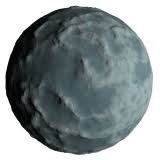 Vall
Vall
Vall is the second of the five natural satellites of Jool. Like the other large Joolian moons, Laythe and Tylo (of which Vall is the smallest), Vall is tidally locked to its parent. Synchronous orbits around Vall are not possible, as they would lie outside of its SOI, at a radius of 3,893,254 meters.
Vall is KSP’s analog to Jupiter’s moon Europa.
Though the bodies have topical similarities, landing on Vall and returning is significantly more challenging than a landing on the Mün, due to the former’s higher gravity, more uneven terrain and distance from Kerbin.
According to former developer NovaSilisko, Vall was planned to be made more like Eeloo, with cracks in the ice and a more chaotic surface than in 0.20.2
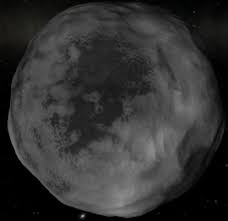 Ike
Ike
Ike is a moon and the only natural satellite of Duna. Ike has steep, rocky slopes and no atmosphere. Ike and Duna are tidally locked due to their proximity and Ike’s size. This means that Ike is in synchronous orbit around its parent body, and that each body is only visible from approximately half of its partner’s surface. (It would be exactly half, but Ike’s slightly eccentric orbit creates regions for which Ike can be seen to set and rise. See Libration, below). It is the largest among planetary satellites relative to the size of the planet that it orbits in the Kerbol system.
An encounter with Ike is quite likely when approaching Duna, provided the player’s trajectory is near the plane of Ike’s orbit. This is because Ike’s sphere of influence is very high relative to the semi-major axis of its orbit — in fact, no other moon in the game has a larger SOI-to-semi-major-axis ratio and no other moon is as close in mass to its parent – Ike has about 6% the mass of Duna.
Stationary orbit around Ike is not possible — it would require an altitude of 1 133.90 km, outside of Ike’s sphere of influence. However, since Ike and Duna are tidally locked to each other, a spacecraft in stationary orbit around Duna will see Ike in a near stable, non-rotating position, as if it were in a stationary Ike orbit. It is not perfectly stationary as Ike has both a non-zero orbital eccentricity and a very small orbital inclination.
Although Duna is the game analog for Mars, Ike does not seem to represent Phobos or Deimos. The Duna-Ike system could be interpreted as an analog of Pluto-Charon – in the real solar system, no moon has a mass as similar to its parent body as Ike.
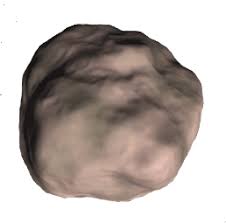 Gilly
GillyGilly is a tiny asteroid, the only natural satellite of Eve, and the smallest celestial body in the Kerbol system.
 Bop
Bop
Bop is one of the five natural satellites of Jool. It seems to be a captured asteroid and has certain similarities to Gilly, another presumably captured asteroid orbiting Eve. Bop has a large crater with a white rim. Some of its mountains rise to nearly 22 km above the surface, meaning any orbit below this could possibly impact the surface. It is comparable to Minmus in that, due to its low gravity, landing is relatively easy. This low gravity results in its bulged, irregular terrain. The brownish surface color may come from solid carbon or iron oxide within the harsh landscape.
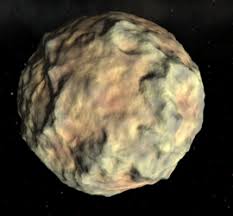 Pol
Pol
Pol is the smallest of the five natural satellites of Jool. The terrain is proportionally quite rough, with large ridges that make it resemble a pollen grain.
Pol has the second-lowest surface gravity in the Kerbol system: only Eve’s moon Gilly is less massive. This makes bipropellant engines on a lander somewhat unnecessary, as landing can be completed with RCS thrusters only. Landing on Pol may still be difficult for inexperienced pilots due to the hazardous terrain with mountains, canyons, 45° slopes and jagged rocks, as well as its tiny sphere of influence.
Pol was added in 0.18. It was not part of the original Joolian system when it was released, along with all the other planets, except the Kerbin system, in 0.17.
Related Posts:
- Kerbal Space Program: Asteroids Guide
- Kerbal Space Program: How to Land on the Mun
- Kerbal Space Program: Secret Launch Points
- Kerbal Space Program: How to Remove the Launcher
- Kerbal Space Program: How to Add Custom Flags

